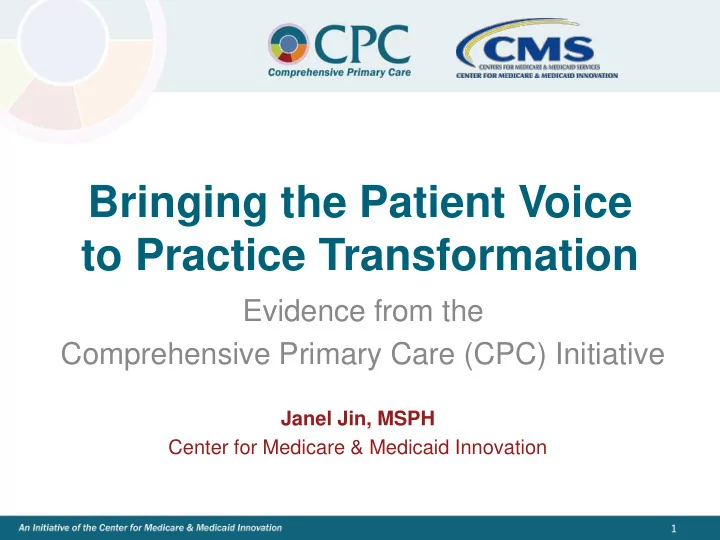

Bringing the Patient Voice to Practice Transformation Evidence from the Comprehensive Primary Care (CPC) Initiative Janel Jin, MSPH Center for Medicare & Medicaid Innovation 1
CPC Aimed to Strengthen Primary Care Theory of Change Participants • 4 year model: 2012-2016 CPC tests whether the • 7 regions : 4 states and portions of provision of comprehensive 3 states primary care at the practice • 496 participating practices site, supported by multi-payer payment reform , continuous • 2,200 practitioners supporting 2.7 use of data , and meaningful million active patients , including use of health information 335,000 Medicare and 78,000 Medicaid beneficiaries technology , can achieve better care, smarter spending, and • 38 public and private payers healthier people. • Robust learning system 2
CPC Centered on Patients and Families 3
Patient Engagement Tactics in CPC Practices were required to implement one of two options: Patient Surveys PFACs Conduct a practice- Convene patient based survey to and family advisory council (PFACs) collect data on patient experience 4
Is practice use of PFACs related to patient engagement in quality improvement? 5
PFACs in CPC Patients, caregivers, clinicians, office staff, and practice leadership Aim for at least 8 patients and caregivers who are diverse and representative of the practice population Regularly meet to discuss improvements in care, processes, and experiences Ongoing, continuous feedback with a broad perspective Information is used to drive change, and results are communicated back to the PFAC Not just a “check -the- box” activity, communication loop is critical 6
Method and Data Source • Retrospective cohort study of CPC practices comparing choice of PFAC, survey, or both in 2015 to practice-rated patient engagement in 2016 • Practice self-assessment via an online portal – Fielded quarterly – 100% response rate 7
Nearly half of practices chose to convene PFACs Practice Choice of Patient Engagement Tactic in 2015 250 235 200 Number of Practices 150 116 94 100 60 50 40 36 34 34 31 29 27 22 19 19 16 16 11 9 9 8 8 7 6 4 0 AR CO NJ NY OH OK OR All-Regions Practice-based Survey Patient and Family Advisory Council Both Total practices: 445 8
Are PFACs associated with higher patient engagement? • Three binary outcomes: 1. Patients generated quality improvement project ideas in the last year 2. Patients were seen as equal partners in quality improvement Dichotomized responses from a 5-point Likert scale (strongly disagree to agree) 3. Practices shared quality improvement data with patients 9
PFACs increased likelihood that patients generated quality improvement ideas % of Practices where Patients Generated Quality Improvement Ideas • Practices with PFACs had 100.0% a 42% increase in 90.0% likelihood compared to 80.0% practices with surveys only 70.0% 60.0% • 54.3% Results similar for both 52.1% 50.0% PFAC groups 40.0% • 30.0% Statistically significant 20.0% 14.5% difference after adjusting 10.0% for region, size, rural/urban 0.0% status, ownership Survey PFAC only Both (n = 235) (n = 116) (n = 94) 10
PFAC practices more likely to view patients as equal partners in quality improvement % of Practices that Agreed Patients are Equal Partners in QI • Practices with PFACs were 100.0% 91.38% 91.5% four times as likely view 90.0% patients as equal partners 80.0% 70.0% • 62.98% Results similar for both 60.0% PFAC groups (PFAC only 50.0% vs PFAC + survey) 40.0% • 30.0% Statistically significant 20.0% difference after adjusting 10.0% for region, size, rural/urban 0.0% status, ownership Survey PFAC only Both (n = 235) (n = 116) (n = 94) 11
Patient engagement tactic did not impact whether quality improvement data was shared % of Practices Who Shared Quality Improvement Data with Patients 100.0% • Low rates of sharing 90.0% data with patients in all 80.0% three groups 70.0% 60.0% 50.0% • No statistical differences 40.0% between groups 30.0% 19.1% 20.0% 10.6% 9.5% 10.0% 0.0% Survey PFAC only Both (n = 235) (n = 116) (n = 94) 12
Limitations • Practices self-selected their tactic • Not nationally representative • Did not measure specific PFAC activities • No control group with zero patient engagement 13
Conclusions PFACs may enhance patient-centered quality improvement Having a PFAC was associated with having patients drive quality improvement projects and viewing patients as equal partners. Notably no significant differences between doing both survey and PFAC versus PFAC only. Patient input and partnership did not translate into data transparency No difference in patients seeing data or results, which is a major piece of quality improvement. More to learn Further investigation is needed to understand elements of successful implementation of patient engagement, and whether or not patient engagement in quality improvement translates into better outcomes. 14
Policy Implications Patient and caregiver input is a critical part of robust 1 quality improvement , especially as alternative payment models grow Primary care practices are uniquely positioned to 2 leverage patient and caregiver input PFACs are an important tool for practices to engage 3 patient voices. CPC+, a new CMS model, requires all practices to convene a PFAC 15
Questions? More on CPC: https://innovation.cms.gov/initiatives/compre hensive-primary-care-initiative/ Contact: janel.jin@cms.hhs.gov 16
Recommend
More recommend